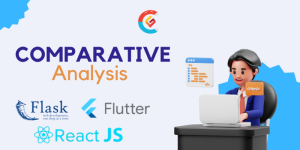
12 Best Frameworks for Hybrid Mobile Apps
Exploring the 12 Top Frameworks for Hybrid Mobile App Development
The technology of hybrid mobile app development is gaining more weight owing to its feature of blending the greatest virtues of native and web apps. In light of an increasing number of mobile apps with a wide range of working platforms, developers are always looking for effective frameworks that speed up the development and build systems designed to produce top-notch apps. In this brief, let’s dive into the top 12 frameworks for hybrid mobile apps, as we will analyze their features, benefits, and downsides.
Introduction to Hybrid Mobile App Development
What are hybrid mobile apps?
Hybrid mobile apps are apps that use web technologies such as (HTML, CSS, JavaScript) and are wrapped in a native environment. This provides developers the advantage of writing the code once and deploying it across numerous platforms that are included in iOS and Android.
Importance of hybrid app development
The development of hybrid apps ensures some remarkable benefits such as shorter development cycles, lower development costs, and the ability to get access to device features through plug-ins. Furthermore, hybrid apps guarantee a uniform interface across various platforms with the scrolling, graphics, and controls being the same.
Benefits of Using Frameworks for Hybrid Mobile Apps
Streamlined development process
Concerning frameworks for the assembling of the hybrid apps, developers have easy access to prebuilt components and libraries, that enable them to save time and programming.
Cost-effectiveness
Developers can drastically cut the development budget by employing frameworks as they scrap the idea of having to write standalone codes for every platform.
Cross-platform compatibility
Frameworks such as React Native and Flutter enable developers to write code once and deploy it across numerous platforms, a process that maintains the software’s performance standards and an intact user experience.
Access to native device features
Hybrid frameworks enable app developers to use plugins to access native device features such as camera, GPS and accelerometer; thus, hybrid apps are being used to create feature-rich apps.
Comparison of Hybrid Mobile App Development Frameworks
| Framework | Language | UI Components | Performance | Native Access | Cross-Platform | Community Support | Learning Curve |
|---|---|---|---|---|---|---|---|
| React Native | JavaScript | Yes | High | Limited | Yes | Large | Moderate |
| Flutter | Dart | Yes | High | Yes | Yes | Large | Moderate |
| Ionic | HTML, CSS, JS | Yes | Moderate | Yes | Yes | Large | Easy |
| Apache Cordova | HTML, CSS, JS | Yes | Moderate | Yes | Yes | Large | Easy |
| NativeScript | JavaScript, TS | Yes | High | Yes | Yes | Moderate | Moderate |
| Xamarin | C# | Yes | High | Yes | Yes | Large | Moderate |
| Framework7 | HTML, CSS, JS | Yes | Moderate | Yes | Yes | Moderate | Easy |
| Onsen UI | HTML, CSS, JS | Yes | Moderate | Yes | Yes | Moderate | Easy |
| Sencha | HTML5, JS | Yes | High | Yes | Yes | Moderate | Moderate |
| Kendo UI | HTML5, JS | Yes | High | Yes | Yes | Large | Moderate |
| Titanium | JavaScript | Yes | Moderate | Yes | Yes | Large | Moderate |
| Corona SDK | Lua | Yes | Moderate | Yes | Yes | Large | Easy |
1. React Native
Overview
A JavaScript framework, built by Facebook, called React Native is widely loved for creating native looking mobile applications. In this way, software engineers with skills in React and JavaScript can develop apps that can be run on both mobile and web platforms.

Features
- Hot Reloading: From the beginning, you become aware of how the app will look and feel as you build it.
- Native Components: Develop apps, using native widgets which will provide native design to your application.
- Large Community: Take advantage of a broad developer community and help resources.
- Performance: With React Native apps you can get the performance of native apps without having to develop them separately.
Pros and cons
Pros
- Fast development cycle.
- Reusable components.
- Excellent performance.
Cons
- Parity to access the native modules.
- The steeper learning curve for beginners is one drawback to electric vehicles.
2. Flutter
Overview
One UI software development kit (SDK) Flutter, which was created by Google, can be used for developing native applications for mobile, web, and desktop from the same codebase by placing it in open-source.

Features
- Widgets: It gives its users a powerful toolbox consisting of widgets that are customizable and can be used to build great-looking interfaces.
- Fast Development: Fast reloading of hot helps in quick prototyping and fixing.
- Expressive UI: The Flutter UI framework is flexible. This enables you to build stunning apps.
- Native Performance: Flutter app’s code compiles to native code so it has a performance close to the native performance.
Pros and cons
Pros
- The same code is on all the platforms.
- Excellent performance.
- The widget set is a great collection.
Cons
- The larger size of the app compared to other options.
- Limited third-party libraries
3. Ionic
Overview
Ionic is an open source mobile application development platform driving the paradigm shift in mobile technology away from native mobile app development towards the use of web technologies such as HTML5, CSS3, and JavaScript. It supplies ‘Mobile-friendly UI components & tools’ as well as efficient means to develop high-quality apps.

Features
- UI Components: Ionic as a library of standard interface elements has been done by Ionic authors for creating responsive apps.
- Native Access: Allow access to specific native device features by Ionic Native plugins.
- Cross-platform Development: Stay within the budget with Ionic’s ability to build once and deploy on any platform.
- Integration with Angular: Ionic and Angular work together for a seamless integration.
Pros and cons
Pros
- Web developers have an easy road to mastery since most tools and frameworks offer ready-made solutions.
- High-speed development and refactoring of the features that are already in place.
- The ability to access the device’s native features is known as the ability.
Cons
- The spread of smartphones has brought a huge opportunity for mobile app developers as they are capable of providing the same functionality as native apps.
- The lack of wide ranging customization possibilities for UI components.
4. Apache Cordova (formerly PhoneGap)
Overview
Apache Cordova, popular as PhoneGap, is an open-source mobile development framework that provides a powerful platform for developers to build cross-platform mobile applications using web technologies.

Features
- Plugin Ecosystem: Using scores enables developers to integrate their apps into the native device features, an intricate system of plugins allows for this.
- Cross-platform Compatibility: Create cross-platform apps using a single base code.
- Web Standards: Cordova apps are a development concept or programming technique that can be built using usual web languages and technologies like HTML, CSS, and JavaScript.
- Community Support: Get access to the pool of experienced developers and community resources.
Pros and cons
Pros
- Easy to meet web standards for the existing web technologies.
- Extensive plugin ecosystem.
- Cross-platform compatibility.
Cons
- Performance may vary across platforms
- Limited access to native APIs
5. NativeScript
Overview
NativeScript is a framework for free and open source development of native mobile applications written in JavaScript TypeScript or Angular. It provides the provision to the developers so that they can feed the programming language itself to form native apps with a single program.

Features
- Truly Native UI: Develop Native apps with native UI components creating an app user interface that looks and feels like a native app.
- Cross-platform Development: Exploit the feature “write once, deploy anywhere” across the various operating systems.
- Access to Native APIs: Using JS APIs, we can get access to device natives.
- Large Plugin Ecosystem: Whichever you will choose, you’re in for a treat.
Pros and cons
Pros
- Truly native performance.
- Access to native APIs.
- Extensive plugin ecosystem.
Cons
- Steep learning curve rather than most other frameworks.
- Limited community support.
6. Xamarin
Overview
Xamarin is an owned framework by Microsoft that allows for cross platforms mobile application development using C#. It provides developers with an opportunity to write code just once and deploy it across all devices including IOS and Android.

Features
- Single Codebase: The code that you write in C# gets deployed across the platforms since you do so once.
- Native Performance: Sharp Xamarin apps are formatted to a native code which is to say they perform excellently.
- Access to Native APIs: Use Xamarin to interact with features of native devices. Forms or Xamarin. iOS and Xamarin. Android.
- Integration with Visual Studio: Xamarin with Visual Studio – Microsoft’s integrated development environment.
Pros and cons
Pros
- Native performance.
- Access to native APIs.
- The visual studio seamlessly integrates.
Cons
- Lack of advocacy by some developers towards these third-party libraries.
- The steeper learning curve for the freshly learners.
7. Framework7
Overview
Framework7 is a full-featured HTML mobile app framework for creating matching iOS and Android apps. It is a large UI library that has a wide range of UI components and tools to build scalable and high-performance mobile applications.

Features
- iOS and Android Themes: Opt for building a native app for either iOS or Android themes depending on the platform you are targeting.
- Rich UI Components: Framework 7 is a library for making quickly responsive and interactive apps with the use of UI components.
- Native-like Experience: Make applications with a native look using Framework7’s UI components in your developed app.
- Easy Integration: Add Framework 7 as an tool that can fully work with other frameworks like Vue. js and React.
Pros and cons
Pros
- Native-like experience.
- Bright collection of the UI components.
- The frameworks are easily integrated with others.
Cons
- Limited to iOS and Android operating system versions only.
- Learning curve for beginners.
8. Onsen UI
Overview
Onsen UI is a free UI framework that offers to build hybrid and progressive web apps. It is a platform independent in nature i. e. it has an array of highly configurable components and tools that can be used to build cross-platform applications.

Features
- Customizable Components: From providing a variety of customizable UI modules to creating captivating apps, Onsen UI has you covered.
- Performance Optimization: Enhance the performance wisely using lazy loading, virtual scrolling, and other techniques.
- Cross-platform Compatibility: The platform is cross-platform, which means you just create once and you can deploy across multiple platforms with Onsen UI.
- Integration with Vue. js and React: The top reason for choosing Onsen UI is its seamless integration with commonly used JavaScript frameworks.
Pros and cons
Pros
- Customizable components.
- Performance optimization features .
- Cross-platform compatibility.
Cons
- Being associated with web and hybrid apps only.
- Learning curve for beginners.
9. Sencha
Overview
Sencha works as a robust tool for developing any web or mobile software using HTML5 and JavaScript. It is an excellent UI toolkit for easy application building providing a set of UI components, tools, and templates.

Features
- Extensive Component Library: Sencha has a long list of UI elements that would help create applications that are ready to use and feature-rich.
- Data Visualization: Use Sencha’s valuable chart tools for visualizing the data.
- Cross-platform Development: Create apps such as websites, mobiles, and desktops using Sencha built-in cross-platform compatibility.
- Enterprise Features: Sencha is a platform that has an enterprise-grade data management and security system.
Pros and cons
Pros
- Extensive component library.
- Data visualization tools.
- Cross-platform development.
Cons
- Steeper learning curve compared to others which are more liked by developers.
- Limited community support.
10. Kendo UI
Overview
Kendo UI all-in-one UI Framework designed for building web and mobile apps. It gives a full UI kit, themes, and tools for the creation of apps that work with full motion and response.

Features
- UI Components: Kendo UI with its collection of such components provides the UI library for the development of web and mobile apps that look modern.
- Themes and Templates: Select from the catalog of beautiful themes, as well as flexible templates for designing a uniquely-looking application.
- Integration with Angular and React: Use Kendo UI in conjunction with other JavaScript frameworks e. g. Angular and React, thus, making the integration process easier.
- Accessibility: Make sure the accessibility of the site is met with the Kendo UI feature that is already built in.
Pros and cons
Pros
- The library of UI components is expansive.
- Themes and templates for easy customization are what we offer.
- Integration with popular frameworks.
Cons
- Steeper learning curve compared to most frameworks since they are more difficult.
- Limited free version features.
11. Titanium
Overview
Titanium is a cross-platform mobile app development framework well-adapted for node. js, allowing the developers to reuse JS code while creating apps for both iOS and Android devices. It helps programmers develop apps that are cross-platform and can be run on different platforms using the same codebase along with the support of native UI components.

Features
- Native UI Components: Develop apps with the fully native UI components embedded for a fully native look and feel.
- Cross-platform Development: Write a code once and deploy it all over the platforms using the Titanium cross-platform compatibility feature as a single code base.
- Access to Native APIs: Take advantage of native device features with the Titanium SDK that supports JavaScript APIs.
- Community Support: Use a sophisticated community of programmers and resources at your disposal.
Pros and cons
Pros
- Native UI components.
- Cross-platform development.
- Access to native APIs.
Cons
- The unavailability of a few native gestures
- More difficult to learn for beginners.
12. Corona SDK
Overview
Corona SDK is a cross-platform framework that is used for mobile games and application development with a focus on 2D format. Lua, a very lightweight scripting language, lets developers create interactive and visually appealing apps.

Features
- Fast Development: Within Corona SDK apps can be quickly developed and prototyped utilizing the development process built-in.
- Cross-platform Compatibility: One build & it can be utilized across different platforms, including iOS, Android, and Kindle.
- Rich Graphics: Build superb graphics apps with the state-of-the-art Corona SDK graphics chamber.
- Large Community: Profit from a group of developers and resources of a huge community.
Pros and cons
Pros
- Fast development cycle.
- Cross-platform compatibility.
- Rich graphics capabilities.
Cons
- The scope is somewhat limited to only those that are specific to 2D apps and games.
- The language constraint is a common issue for the speakers of the native languages.
Navigating the Hybrid Mobile App Development Landscape
In conclusion, the field of cross platform mobile app development is wide, more frameworks do exist whereby developers are free to choose. Each framework is equipped with its own set of features, advantages, and constraints. You may be a fresh policy maker or an experienced developer; what matters is your project requirements, the availability of technology, and your desired results in this context.
Whether you are a React Native and Flutter developer or you are looking at Ionic and Xamarin then you have many choices to explore depending on your preferences and project requirements. It will help developers in the effective and economic development process ensuring that the quality of hybrid mobile applications will be high.
Given the fact that mobile app development is undergoing rapid changes, always being up-to-date with the newest technologies required for the success of the business is very important. Whether it’s a basic mobile app or a complex enterprise solution that you’re developing, selecting the right framework can be that crucial factor that will give you a step into the right direction towards the fulfillment of your goals. Ready to transform your app idea into reality? Partner with CGit, your trusted software house for cutting-edge mobile app development solutions
FAQs
1. What is a hybrid mobile app?
A cross-platform hybrid mobile app is an application that is built using web technologies (HTML, CSS, JavaScript) and adds a container that creates just a small native part so that it can be deployed across multiple platforms.
2. Why use frameworks for hybrid mobile app development?
Frameworks break through the development process in a way that helps to save the developers’ money, offer support for device-native features, and ensure compatibility with different platforms.
3. Which framework is best for beginners?
Choices of frameworks like Ionic and Apache Cordova are widely accepted by beginners as they are relatively easy to use and comply with extensive documentation.
4. What is the difference between React Native and Flutter?
React Native is implemented with the use of JavaScript language and has a huge community of developers, while Flutter takes Dart as its element and offers various widgets that can be quickly customized to bring beauty into the app.
5. How do I choose the right framework for my project?
Think about whether you require special tools, the level of expertise needed, and the performance of the technology as well as the public reception of the framework before making a decision.




